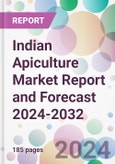Indian Apiculture Market Report and Forecast 2024-2032
Apiculture, more commonly recognised as beekeeping, is the maintenance of bee colonies, usually in hives. This practice is primarily done to produce honey, but it also generates other beneficial products like beeswax, royal jelly, and pollen. India, with its diverse flora, offers an ideal environment for various bee species, making it a favourable region for apiculture.
Organic honey and its associated products are gaining popularity among consumers and is thus considered to be one of the major Indian apiculture market trends. With a globally increasing emphasis on natural and organic consumables, Indian honey, known for its purity and distinct flavour profiles depending on the floral source, is experiencing burgeoning demand. This demand is not limited to domestic boundaries but also on the export potential.
The Indian apiculture market growth can be attributed to the extensive application of bee products in various sectors. Honey, besides being a natural sweetener, has found its way into the pharmaceutical and cosmetic industries due to its therapeutic properties. Beeswax is an essential ingredient in cosmetics, particularly in lip balms and lotions, owing to its moisturising benefits. Meanwhile, the medicinal attributes of royal jelly, a secretion used in the nutrition of larvae and adult queen bees, have led to its increased consumption as a dietary supplement.
Another factor bolstering the Indian apiculture market demand has been the government's active promotion of beekeeping as a sustainable livelihood. With numerous schemes and training programs, more farmers and entrepreneurs are venturing into this field. The resultant increase in beekeeper’s aids in honey production and boosts pollination, benefiting agriculture and horticulture sectors as well.
The Indian apiculture market analysis reveals that technological advancements are further refining apiculture practices. Modern tools and equipment, coupled with training on best practices, have increased honey yields and reduced bee mortality. Besides, the establishment of honey testing labs ensures product quality, strengthening consumer trust.
Moreover, with the recent boost in health awareness and the trend towards natural remedies, there is a noticeable rise in the demand for honey as a dietary staple. People have started recognising honey's benefits, not only as a sweetener but also as a health supplement, which further bolsters the market.
This product will be delivered within 5-7 business days.
Market Outlook
According to the report, the Indian apiculture market reached a value of almost INR 26.652 Billion in the year 2023. Aided by rising consumer awareness regarding various health benefits of honey consumption and growing consumer shift towards ayurveda, the market is projected to further grow at a CAGR of 12% between 2024 and 2032 to reach a value of INR 74.022 Billion by 2032.Apiculture, more commonly recognised as beekeeping, is the maintenance of bee colonies, usually in hives. This practice is primarily done to produce honey, but it also generates other beneficial products like beeswax, royal jelly, and pollen. India, with its diverse flora, offers an ideal environment for various bee species, making it a favourable region for apiculture.
Organic honey and its associated products are gaining popularity among consumers and is thus considered to be one of the major Indian apiculture market trends. With a globally increasing emphasis on natural and organic consumables, Indian honey, known for its purity and distinct flavour profiles depending on the floral source, is experiencing burgeoning demand. This demand is not limited to domestic boundaries but also on the export potential.
The Indian apiculture market growth can be attributed to the extensive application of bee products in various sectors. Honey, besides being a natural sweetener, has found its way into the pharmaceutical and cosmetic industries due to its therapeutic properties. Beeswax is an essential ingredient in cosmetics, particularly in lip balms and lotions, owing to its moisturising benefits. Meanwhile, the medicinal attributes of royal jelly, a secretion used in the nutrition of larvae and adult queen bees, have led to its increased consumption as a dietary supplement.
Another factor bolstering the Indian apiculture market demand has been the government's active promotion of beekeeping as a sustainable livelihood. With numerous schemes and training programs, more farmers and entrepreneurs are venturing into this field. The resultant increase in beekeeper’s aids in honey production and boosts pollination, benefiting agriculture and horticulture sectors as well.
The Indian apiculture market analysis reveals that technological advancements are further refining apiculture practices. Modern tools and equipment, coupled with training on best practices, have increased honey yields and reduced bee mortality. Besides, the establishment of honey testing labs ensures product quality, strengthening consumer trust.
Moreover, with the recent boost in health awareness and the trend towards natural remedies, there is a noticeable rise in the demand for honey as a dietary staple. People have started recognising honey's benefits, not only as a sweetener but also as a health supplement, which further bolsters the market.
Market Segmentation
The market can be divided based on product type, application, and region.Market Breakup by Product Type
- Honey
- Beeswax
Market Breakup by Application
- Direct Consumption
- Food and Beverages
- Pharmaceuticals
- Cosmetics
- Others
Market Breakup by Region
- North India
- South India
- East India
- West India
Competitive Landscape
The report looks into the market shares, plant turnarounds, capacities, investments, and mergers and acquisitions, among other major developments, of the leading companies operating in the Indian apiculture market.This product will be delivered within 5-7 business days.
Table of Contents
1 Preface2 Report Coverage - Key Segmentation and Scope4 Key Assumptions7 Opportunities and Challenges in the Market11 Value Chain Analysis13 Key Trends and Developments in the Market
3 Report Description
5 Executive Summary
6 Snapshot
8 Indian Apiculture Market Analysis
9 Regional Analysis
10 Market Dynamics
12 Competitive Landscape
List of Key Figures and Tables
Methodology

LOADING...








